11.5 Assess Your UnderstandingPrinted Page 799
Concepts and Vocabulary
True or False To integrate a vector function r=r(t), integrate each component individually.
True
True or False When integrating a vector function r=r(t), there is no need to add a constant of integration.
False
Skill Building
In Problems 3–10, find each integral.
∫(sinti−costj+tk)dt
−costi−sintj+12t2k+c
∫(costi+sintj−k)dt
∫(t2i−tj+etk)dt
13t3i−12t2j+etk+c
∫(eti−√tj+t2k)dt
∫(lnti−tlntj−2k)dt

∫(i+lntj+1tk)dt
∫[(t−2)i−(t−2)2j+k]dt
(12t2−2t)i−13(t−2)3j+tk+c
∫[(3t+1)i+(3t+1)2j+(3t+1)−1k]dt
In Problems 11–16, solve each vector differential equation with the given condition.
r′(t)=eti−lntj+2tk,r(1)=j+k
r(t)=(et−e)i+(t−tlnt)j+t2k
r′(t)=ti+e−tj−1tk,r(1)=i−j+2k
r′(t)=2sinti+costj+k,r(0)=i−j
r(t)=(3−2cost)i+(sint−1)j+tk
r′(t)=cos(2t)i+sin(2t)j+2k,r(0)=i+k
r′(t)=t−1i+tj+t2k,r(1)=i+j+k
r(t)=(lnt+1)i+12(t2+1)j+13(t3+2)k
r′(t)=t3i+1t+1j+k,r(0)=i+j+k
In Problems 17–24, find the velocity, speed, and position of a particle having the given acceleration, initial velocity, and initial position.
a(t)=−32k,v(0)=0,r(0)=0
v(t)=−32tk, v(t)=32t, and r(t)=−16t2k
a(t)=−32k,v(0)=i+j,r(0)=0
a(t)=costi+sintj,v(0)=i,r(0)=j
v(t)=(sint+1)i+(1−cost)j, v(t)=√3+2sint−2cost, and r(t)=(t−cost+1)i+(t−sint+1)j
a(t)=costi+sintj,v(0)=j,r(0)=i
a(t)=−9.8k,v(0)=i,r(0)=5k
v(t)=i−9.8tk, v(t)=√1+96.04t2, and r(t)=ti+(5−4.9t2)k
800
a(t)=−9.8k,v(0)=i+j,r(0)=2i
a(t)=e−ti+j,v(0)=i+j,r(0)=i−j
v(t)=(2−e−t)i+(t+1)j, v(t)=√e−2t−4e−t+t2+2t+5, and r(t)=(2t+e−t)i+(12t2+t−1)j
a(t)=t2i−e−tk,v(0)=i−j,r(0)=k
Applications and Extensions
In Problems 25–30, assume g=9.8m/s2.
Projectile Motion A projectile is fired at an angle of 30 to the horizontal with an initial speed of 520 m/s. What are its range, the time of flight, and the greatest height reached?
The range ≈23,895 m, the time of flight ≈53 s, and the greatest height reached ≈3449 m.
Projectile Motion A projectile is fired with an initial speed of 200 m/s at an inclination of 60 to the horizontal. What are its range, the time of flight, and the greatest height reached?
Projectile Motion A projectile is fired with an initial speed of 100 m/s at an inclination of tan−1(512) to the horizontal.
- (a) Find parametric equations of the path of the projectile.
- (b) Find the range.
- (c) How long is the projectile in the air?
- (d)
 Graph the trajectory of the projectile.
Graph the trajectory of the projectile.
- (a) x=1200t13 and y=−4.9t2+500t13
- (b) Range ≈724.6 m
- (c) Time of flight ≈7.8 s
- (d)
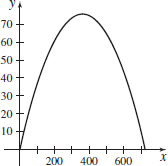
Projectile Motion A projectile is fired with an initial speed of 120 m/s at an inclination of tan−1(34) to the horizontal.
- (a) Find parametric equations of the path of the projectile.
- (b) Find the range.
- (c) How long is the projectile in the air?
- (d)
 Graph the trajectory of the projectile.
Graph the trajectory of the projectile.
Projectile Motion A projectile is fired up a hill that makes a 30° %TCIMACRO{\U{b0}}% %BeginExpansion {{}^\circ}% %EndExpansion angle to the horizontal. Suppose the projectile is fired at an angle of inclination of 45° %TCIMACRO{\U{b0}}% %BeginExpansion {{}^\circ}% %EndExpansion to the horizontal with an initial speed of 100\textrm{ft}/\!\textrm{s}. See the figure.
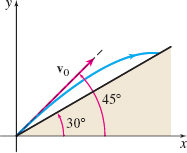
- (a) How far up the hill does the projectile land?
- (b) How long is the projectile in the air?
- (a) The projectile travels approximately 152.5 feet up the hill.
- (b) The projectile is in the air for approximately 1.9 seconds.
Projectile Motion A projectile is propelled horizontally at a height of 3 m above the ground in order to hit a target 1 m high that is 30 m away. See the figure below. What should the initial velocity {\bf v}_0 of the projectile be?

A force whose magnitude is 5N and whose direction is along the positive x-axis is continuously applied to a projectile of mass m=1 kg. At t=0{s}, the position of the object is the origin and its velocity is 3{m}/\!{s} in the direction of the positive y-axis.
- (a) Find the velocity and speed of the projectile after t seconds.
- (b) Find the position after the force has been applied for t seconds.
- (c) How long is the projectile in the air?
- (d) Describe the path of the projectile.
- (a) \mathbf{v}(t) = 5t \mathbf{i} + (-9.8t+3)\mathbf{j} and v(t) = \sqrt{121.04t^2-58.8t+9}
- (b) \mathbf{r}(t) = \dfrac52 t^2 \mathbf{i} + (-4.9t^2+3t) \mathbf{j}
- (c) \approx \!0.612 s
- (d)
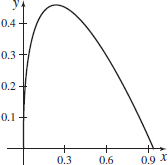
An object of mass m is propelled from the point (1,2) with initial velocity \mathbf{v}_{0}=3\mathbf{i}+4\mathbf{j}. Thereafter, it is subjected only to the force \mathbf{F}=\dfrac{m}{\sqrt{2}}\left( - \mathbf{i}-\mathbf{j}\right) . Find the vector equation for the position of the object at any time t>0.
Projectile Motion: Basketball In a Metro Conference basketball game on January 21, 1980, between Florida State University and Virginia Tech, a record was set. Les Henson, who is 6 ft 6 in. tall, made a basket from 89\dfrac{1}{4} ft down court to win the game for Virginia Tech by a score of 79 to 77. Assuming he released the ball at a height of 6 ft 6 in. and threw it at an angle of 45° %TCIMACRO{\U{b0}} %BeginExpansion {{}^\circ} %EndExpansion (to maximize distance), with what initial velocity was the ball tossed? See the figure. (Assume g=32{ft}/\!{s}^{2}.)
v_0\approx 54.521 ft/s
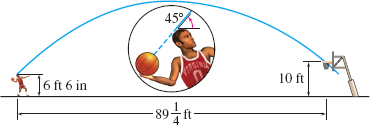
Projectile Motion: Airplanes A plane is flying at an elevation of 4.0\textrm{ km} with a constant horizontal speed of 400\textrm{ km}/\!{h} toward a point directly above its target T. See the figure. At what angle of sight \alpha should a package be released in order to strike the target? (Hint: g\approx 127{,}008{km}/\!{h}^{2}.)
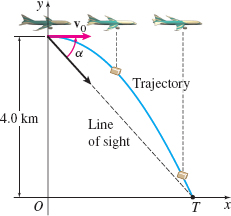
Projectile Motion: Baseball A baseball is hit at an angle of 45° %TCIMACRO{\U{b0}}% %BeginExpansion {{}^\circ}% %EndExpansion to the horizontal from an initial height of 3 ft. If the ball just clears the vines in front of the bleachers in Wrigley Field, which are 10 ft high and a distance of 400 ft from home plate, what was the initial speed of the ball? How long did it take the ball to reach the vines?
The initial speed of the ball is approximately 114 ft/s. It took the ball approximately 5 s to reach the vines.
Projectile Motion: Baseball An outfielder throws a baseball at an angle of 45° %TCIMACRO{\U{b0}}% %BeginExpansion {{}^\circ}% %EndExpansion to the horizontal from an initial height of 6 ft. Suppose he can throw the ball with an initial velocity of 100 ft/s.
- (a) What is the furthest the outfielder can be from home plate to ensure that the ball reaches home plate on the fly?
- (b) How long is the ball in flight?
- (c) Use (a) and (b) to determine how fast a player must run to get from third base to home plate on a fly ball and beat the throw to score a run. (Hint: It is 90 {ft} from third base to home plate.)
801
Projectile Motion: Football In a field goal attempt on a flat field, a football is kicked at an angle of 30° %TCIMACRO{\U{b0}}% %BeginExpansion {{}^\circ}% %EndExpansion $ to the horizontal with an initial speed of 65{ft}/\!{s}.
- (a) What horizontal distance does the football travel while it is in the air?
- (b) To score a field goal, the ball must clear the cross bar of the goal post, which is 10 ft above the ground. What is the furthest from the goal post the kick can originate and score a field goal?
- (a) Range \approx 114.342 ft
- (b) \approx \!93 ft
Projectile Motion: Skeet Shooting A gun, lifted at an angle \theta _{0} to the horizontal, is aimed at an elevated target T, which is released the moment the gun is fired. See the figure. No matter what the initial speed v_{0} of the bullet is, show that it will always hit the falling target.
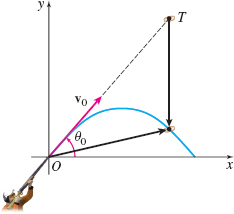
- (a) Show that the maximum range of the projectile with position vector \mathbf{r}(t)=(v_{0}\cos \theta )t\mathbf{i} +\left[(v_{0}\sin \theta )t-\dfrac{1}{2}gt^{2}\right]\mathbf{j} occurs when \theta\;=\;\dfrac{\pi }{4}.
- (b) Show that the maximum range is \dfrac{v_{0}^{2}}{g}.
See Student Solutions Manual.
Show that the speed of the projectile whose position vector is given by \mathbf{r}( t)\;=\;(v_{0}\cos \theta )t\mathbf{i}+\left[ -\dfrac{1}{2}gt^{2}+(v_{0}\sin \theta )t\right] \mathbf{j} is least when the projectile is at its highest point.
Show that a particle subject to no outside forces is either stationary or moves with constant speed along a straight line.
See Student Solutions Manual.
Show that if \mathbf{r}^{\prime }(t)=\mathbf{0} for all t on some interval I, then \mathbf{r}(t)=\mathbf{c}, a constant vector, for all t in I.
Show that if \mathbf{f}^{\kern1pt\prime }(t)=\mathbf{g}^{\prime }(t) for all t in some interval I, then \mathbf{f}(t)=\mathbf{g}(t)+\mathbf{c } for all t in I.
See Student Solutions Manual.
Challenge Problems
If \mathbf{c} is a constant vector and \mathbf{r=r} ( t) is continuous on a closed interval [ a,b] , show that \begin{equation*} \int_{a}^{b}[\mathbf{c}\,{\cdot}\, \mathbf{r}(t)]dt=\mathbf{c}\,{\cdot}\, \int_{a}^{b} \mathbf{r}(t)~dt \end{equation*}
Use the result of Problem 44 to show that \begin{equation*} \left\Vert \int_{a}^{b}\mathbf{r}(t)dt\right\Vert \leq \int_{a}^{b}\left\Vert \mathbf{r}(t)\right\Vert dt \end{equation*}
[Hint: Set \mathbf{c}=\int_{a}^{b}\mathbf{r}(t)dt and find \left\Vert \mathbf{c}\right\Vert ^{2}].
See Student Solutions Manual.
If \mathbf{c} is a constant vector and \mathbf{r}(t) is continuous on a closed interval [a,~b], prove that \begin{equation*} \int_{a}^{b}[\mathbf{c}\times \mathbf{r}(t)]dt=\mathbf{c}\times \int_{a}^{b}\mathbf{r}(t)dt \end{equation*}
